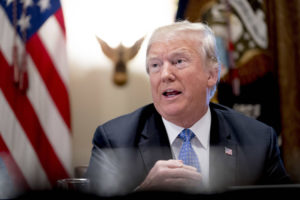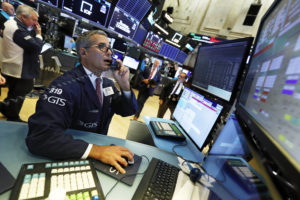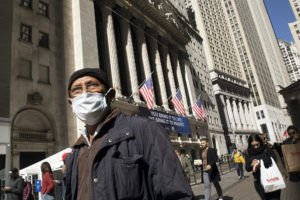Unemployment Rate Hits 18-Year Low
U.S. employers add 223,000 jobs in May, helping to lower the unemployment rate to 3.8 percent.WASHINGTON — U.S. employers extended a streak of solid hiring in May, adding 223,000 jobs and helping lower the unemployment rate to an 18-year low of 3.8 percent from 3.9 percent in April.
Average hourly pay rose 2.7 percent from a year earlier, a slightly faster annual rate than in April, the Labor Department reported Friday. But pay growth remains below levels that are typical when the unemployment rate is this low.
Still, the report shows that the nearly 9-year old economic expansion — the second-longest on record — remains on track. Employers appear to be shrugging off recent concerns about global trade disputes.
Roughly an hour before the employment data was released at 8:30 a.m. Eastern time, President Donald Trump appeared to hint on Twitter that a strong jobs report was coming. “Looking forward to seeing the employment numbers at 8:30 this morning,” he tweeted.
The president is normally briefed on the monthly jobs report the day before it is publicly released, and he and other administration officials are not supposed to comment on it beforehand.
Larry Kudlow, the president’s top economic adviser, defended Trump’s tweet in an interview on CNBC, saying that it followed “law and custom.”
“I don’t think he gave anything away, incidentally,” Kudlow said.
Friday’s report showed that hiring in the United States is benefiting a wider range of Americans: The unemployment rate for high school graduates reached 3.9 percent, a 17-year low. For black Americans, it hit a record low of 5.9 percent.
“The economy and labor market appear to be firing on all cylinders, with all sectors showing strength,” said Paul Ashworth, chief U.S. economist at Capital Economics.
Investors applauded the report. The Dow Jones industrial average rose 221 points, or 0.9 percent. Other indexes also moved higher.
The healthy jobs data makes it more likely that the Federal Reserve will keep raising interest rates this year — at least twice more and possibly three more times, after having raised its key rate in March. Traders now put the likelihood of four rate hikes for 2018 at about one-third, up from one-quarter on Thursday.
With the jobless rate so low, employers have complained for months about the difficulty of finding workers to fill jobs. The number of open positions reached a record high in March. Friday’s report suggests that some companies are making extra efforts to find people.
For example, the number of part-time workers who would prefer full-time jobs declined slightly and is down 6 percent from a year ago. That may mean that businesses are converting some part-timers to full-time work.
Companies are also hiring the long-term unemployed — those who have been out of work for six months or longer. Their ranks have fallen by nearly one-third in the past year. That’s important because economists worry that people who are out of work for long periods can see their skills erode. Yet employers now seem more willing to hire them.
The unemployment rate, rounded to one decimal, is the lowest since April 2000. But the unrounded figure is 3.75 percent. That is the lowest since 1969, some economists notes.
Debbie Thomas, owner of Thomas Hill Organics, a restaurant in Paso Robles, California, said that finding enough qualified people to hire is her biggest challenge right now. She has raised pay by about a dollar an hour in the past year for cooks and dishwashers but is reluctant to boost wages much higher. The more-expensive organic food she uses also adds to her costs.
“You don’t want to price yourself out of the market,” Thomas said.
The job gains in May were broad-based: Professional and business services, which includes higher-paying fields such as accounting and engineering, added 31,000 jobs. Health care, a consistent job engine for the entire recovery, gained nearly 32,000.
Manufacturing, which is benefiting from increased business investment in machinery and other equipment, added 18,000 jobs, and construction 25,000.
Some economists remain concerned that the Trump administration’s aggressive actions on trade could hamper growth. The administration on Thursday imposed tariffs on steel and aluminum imports from key allies in Europe, Canada and Mexico. Earlier in the week, it threatened to hit China with tariffs on $50 billion of its goods.
While the tariffs themselves would likely have only a scant direct impact on the economy, ongoing uncertainty about which trading partners and which goods might be hit next could disrupt some companies’ expansion plans.
For now, the solid hiring data coincides with other evidence that the economy is on firm footing after a brief slowdown in the first three months of the year. The economy grew at a modest 2.2 percent annual rate in the January-March quarter, after three quarters that had averaged roughly 3 percent.
But consumers have started to spend more freely, after having pulled back in the January-March quarter. That gain could reflect in part the effect of the Trump administration’s tax cuts, which might be encouraging more Americans to step up spending. Consumer spending rose in April at its fastest pace in five months.
Companies are spending more on industrial machinery, computers and software — signs that they’re optimistic enough about future growth to expand their capacity. A measure of business investment rose in the first quarter by the most in 3½ years. That investment growth has been spurred partly by higher oil prices, which have encouraged the construction of more drilling rigs.
Macroeconomic Advisers, a forecasting firm, says it now foresees the economy expanding at a robust 4 percent annual pace in the April-June quarter, which would be the fastest in nearly four years. That is up from its forecast last week of less than a 3 percent rate for the current quarter.
Your support matters…Independent journalism is under threat and overshadowed by heavily funded mainstream media.
You can help level the playing field. Become a member.
Your tax-deductible contribution keeps us digging beneath the headlines to give you thought-provoking, investigative reporting and analysis that unearths what's really happening- without compromise.
Give today to support our courageous, independent journalists.





You need to be a supporter to comment.
There are currently no responses to this article.
Be the first to respond.